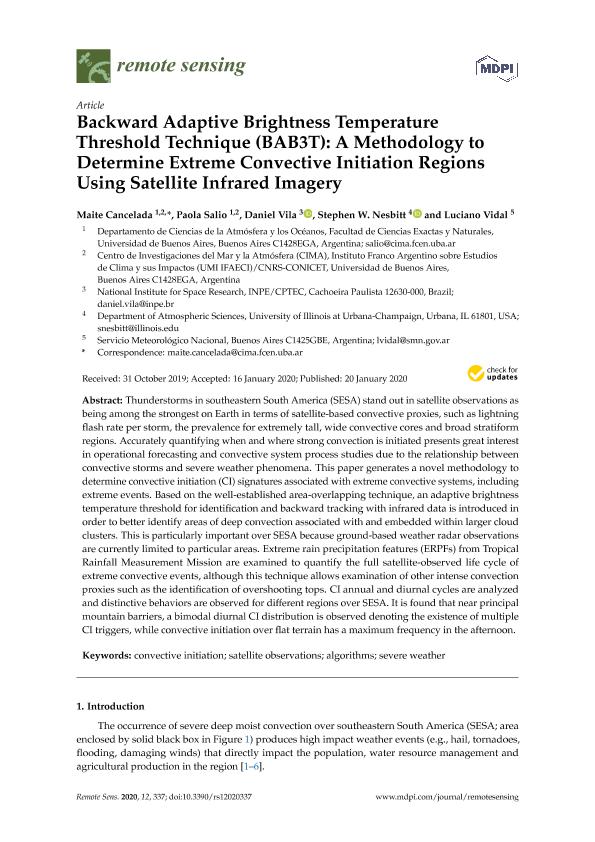Artículo
Backward adaptive brightness temperature threshold technique (BAB3T): A methodology to determine extreme convective initiation regions using satellite infrared imagery
Fecha de publicación:
01/2020
Editorial:
Molecular Diversity Preservation International
Revista:
Remote Sensing
ISSN:
2072-4292
Idioma:
Inglés
Tipo de recurso:
Artículo publicado
Clasificación temática:
Resumen
Thunderstorms in southeastern South America (SESA) stand out in satellite observations as being among the strongest on Earth in terms of satellite-based convective proxies, such as lightning flash rate per storm, the prevalence for extremely tall, wide convective cores and broad stratiform regions. Accurately quantifying when and where strong convection is initiated presents great interest in operational forecasting and convective system process studies due to the relationship between convective storms and severe weather phenomena. This paper generates a novel methodology to determine convective initiation (CI) signatures associated with extreme convective systems, including extreme events. Based on the well-established area-overlapping technique, an adaptive brightness temperature threshold for identification and backward tracking with infrared data is introduced in order to better identify areas of deep convection associated with and embedded within larger cloud clusters. This is particularly important over SESA because ground-based weather radar observations are currently limited to particular areas. Extreme rain precipitation features (ERPFs) from Tropical Rainfall Measurement Mission are examined to quantify the full satellite-observed life cycle of extreme convective events, although this technique allows examination of other intense convection proxies such as the identification of overshooting tops. CI annual and diurnal cycles are analyzed and distinctive behaviors are observed for different regions over SESA. It is found that near principal mountain barriers, a bimodal diurnal CI distribution is observed denoting the existence of multiple CI triggers, while convective initiation over flat terrain has a maximum frequency in the afternoon.
Palabras clave:
ALGORITHMS
,
CONVECTIVE INITIATION
,
SATELLITE OBSERVATIONS
,
SEVERE WEATHER
Archivos asociados
Licencia
Identificadores
Colecciones
Articulos(CIMA)
Articulos de CENTRO DE INVESTIGACIONES DEL MAR Y LA ATMOSFERA
Articulos de CENTRO DE INVESTIGACIONES DEL MAR Y LA ATMOSFERA
Citación
Cancelada, Maite; Salio, Paola Veronica; Vila, Daniel; Nesbitt, Stephen William; Vidal, Luciano; Backward adaptive brightness temperature threshold technique (BAB3T): A methodology to determine extreme convective initiation regions using satellite infrared imagery; Molecular Diversity Preservation International; Remote Sensing; 12; 2; 1-2020; 1-19
Compartir
Altmétricas




